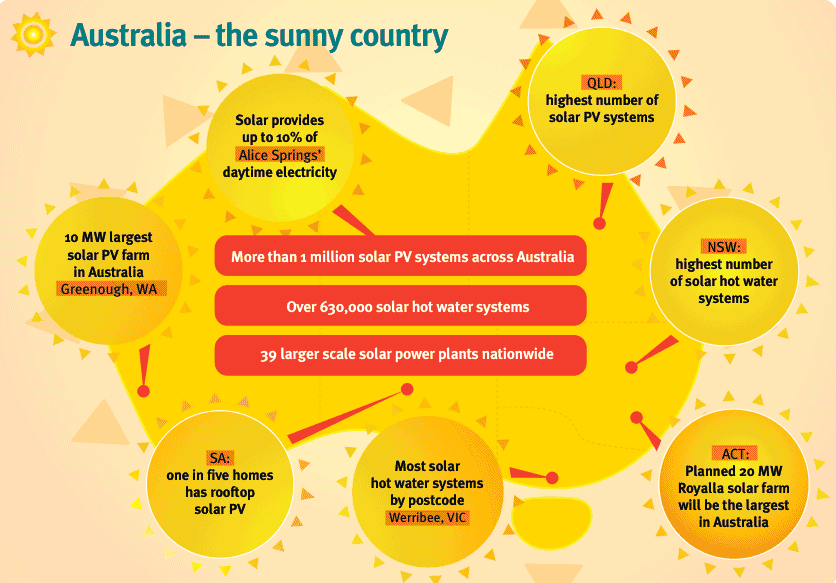It turns out that Australians may not as dumb as Dick Smith would have us believe, at least as far as electricity choices are made. The self-made entrepreneur, aviator and now aspiring energy expert made much in his “Ten Bucks a Litre” documentary last week about the inadequacy of renewables – they are expensive, and intermittent, and they can’t do the job.
And in a blithe dismissal of the ability of households to act smarter, and substitute energy-hogging appliances with more efficient ones, he said there would never be enough solar panels on a household to here will never be enough panels to meet their requirement.
But Climate Commissioner Tim Flannery has another viewpoint: He says Australians are rushing to embrace solar for a simple reason – it is saving them money, because it is cheaper to generate electricity on the rooftop of their home than to source it through the massive grid. And because it also has the happy outcome of forcing dirty electricity generation out of the market.
The Climate Commission today releases a detailed 45-page report on the future of solar – a study that is likely to get buried under the frenzy of media attention on the first day of the election campaign. And that’s a pity, says Flannery, because the “solar revolution” has gone virtually un-noticed by the mainstream media, but its impact is already being felt within the electricity industry.
Flannery says the arrival of cost-competitive solar is one of the biggest things that has happened in the fight to address climate change and limit greenhouse gas emissions. “Solar is clearly is good for the battle on climate change,” Flannery told RenewEconomy in an interview. “It is replacing old, polluting infrastructure with new, clean infrastructure. For me, solar is the big story. It is way above everything else (that has been achieved).
Flannery dismisses the ideas promoted by the likes of Dick Smith – who with the aid of images from dancing “greenies” at a Bellingen festival – likes to promote the idea that renewables are expensive and intermittent, and therefore of not much practical use. Flannery says such ideas are “well outdated”. From the perspective of individual consumer, he notes, rooftop solar is already cost competitive with the grid.
Flannery says solar will challenge utilities, and the centralized generation model of the electricity sector, and will have the same impact as the internet has had on the media, where the viability of printed newspapers is threatened by the popularity of online information.
“This is coming, like it or not,” Flannery says. “And nothing short of banning solar PV will prevent it. We can have a stable grid with a lot of solar PV. We may have to look at what the future is for major utilities, and this is a significant issue because it looks at how we run a new grid. But it is not insurmountable.”
Flannery’s comments echo the conclusions of a range of international investment banks, independent analysts, as well as the biggest utilities and generators in the US and Europe, who all conclude that solar will become a “no-brainer” for consumers (be they homes or businesses).
Smith’s message was that renewables were expensive and intermittent, and therefore couldn’t do the job. It’s a conclusion typical of those who advocate, as Smith does, that the only solution is nuclear, and who cannot see beyond the current centralised model of generation. It’s at odds with most modern thinking, even including the conclusions of the 100% renewables scenario completed by the Australian Energy Market Operator.
But technology has moved on, and so have costs. The Climate Commission report concludes that solar PV is already providing the most affordable form of electricity production for retail consumers – a conclusion already arrived at by international investment banks, independent analysts and the biggest utilities and generators in the US and Europe, who all conclude that solar will become a “no-brainer” for consumers (be they homes or businesses).
Instead of a market dominated by a few large producers or electricity providers, Flannery says there are now countless numbers of “pro-sumers”, householders and businesses that produce their own electricity. That changes the financial model for existing utilities, he says, because it lowers demand at peak times when they are used to making most of their money.
“The economic model that we run the power industry doesn’t work any more,” he says. And the industry faces an even bigger challenge with the arrival of batteries, which he suspects will be competitive within a few years.
“This is an evolutionary thing – and the one thing that we can do is to make sure that we have a stable electricity supply. We will need the right elements in place to make sure that (those elements) are delivered in time – and we can look to Germany for that.” One of the key issues is the cost of the grid, and how it impacts those who do not have access to solar.
The Climate Commission report has a couple of interesting graphics which we thought we would highlight. The first is this, looking at the amount invest by each country in 2012 in solar, and the country’s relative solar resources. It should be pointed out that the $3.8 billion spent in Australia came almost exclusively from households. Much of the investment in other countries would have come from commercial investments in larger scale installations. The table at the end highlights the extent of solar hot water usage, which still dominates solar PV by a large factor.
The second graph is a bit of fun – and highlights some of the individual records for each state. Whatever happened to Tasmania?












